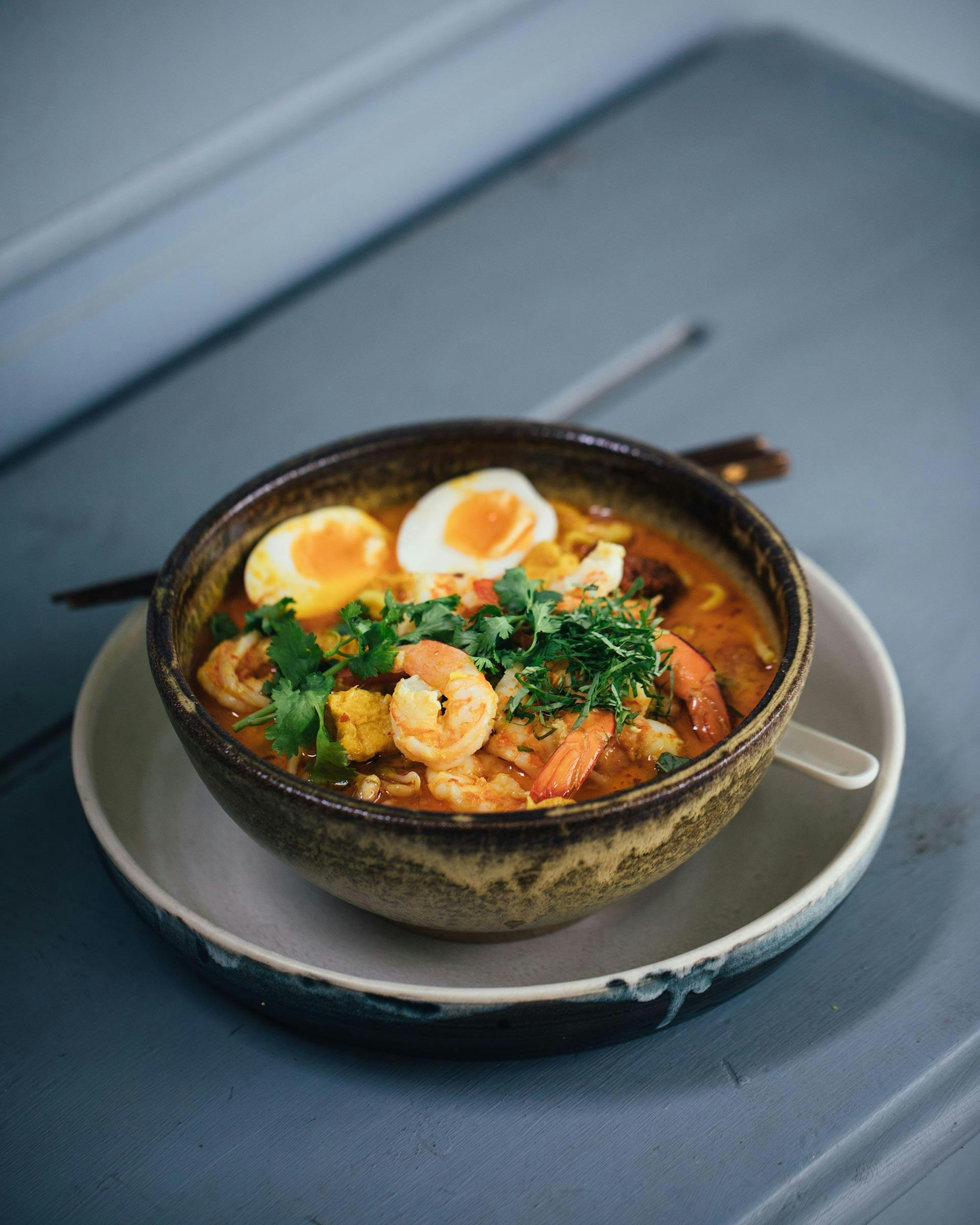How to Make an Authentic Prawn Laksa

This is a recipe for a simple but authentic prawn laksa lemak is a lot easier than it looks. You could easily add chicken or other seafood to this recipe if you preferred.
Ingredients
1 kg raw, unpeeled large prawns
4 tablespoons vegetable oil
½ cup dried shrimp, soaked in hot water
2 teaspoons salt
2 teaspoons sugar
1 teaspoon fish sauce
2 x 425 ml tins coconut milk
250 g fried tofu puffs, halved
1 kg fresh Hokkien noodles
200 g dried rice vermicelli noodles
200 g fried fish cakes, sliced
300 g bean sprouts
8 eggs
1 cup loosely packed Vietnamese mint leaves, finely shredded to serve
1 Lebanese cucumber, shredded, to serve
Prawn Oil
1/3 of the reserved prawn heads and shells
about 1/2 a cup of vegetable oil
a pinch of salt
1 tbsp tomato paste (optional)
Prawn Stock
2/3 of the reserved prawn heads and shells
Laksa paste (makes double)
15 dried chillies, seeded and soaked in hot water for around 20 minutes
4 large red chillies, seeded
1 tablespoon belacan (shrimp paste)
6 shallots, or 1 large brown onion, peeled and roughly chopped
10 garlic cloves, peeled
5 cm piece of fresh ginger, peeled
5 cm piece of fresh galangal, peeled
5 cm piece of fresh turmeric, peeled
3 lemongrass stems, white part only
2 tablespoons ground coriander
6 candlenuts, or macadamia nuts
Chilli sambal
5 dried chillies, soaked
3 large red chillies
2 eschallots, or 1/2 small onion, roughly chopped
1 teaspoon belacan (shrimp paste)
½ cup peanut oil
a pinch of sugar
Method
Peel the prawns, leaving the tails on if you like. Add two-thirds of the shells to the a pot with 2.5L of water and simmer for about 20 minutes. Stand for at least 10 minutes, then strain, discarding the shells and reserving the stock. Devein and butterfly the prawns and refrigerate.
Blend all the laksa rempah ingredients into a smooth paste, adding a little of the dried shrimp steeping liquid if you need to help the blades catch. Any remaining steeping liquid can be combined with the prawn stock.
Heat a large saucepan over medium heat and add a little oil for the prawn oil. Fry the remaining prawn heads and shells until very fragrant, then add the salt and remaining oil and cook on low heat for about 10 minutes. Certain varieties of prawns have more red colour than others, so if your prawn shells are not very red and you prefer a more vibrant red oil you can add a little tomato paste when frying the prawn heads. Strain to remove remove the heads and shells, reserving the oil.
Heat 4 tablespoons of vegetable oil in a large pot (you can use the prawn oil for this if you like, or save it for adding later). Add half the laksa rempah (refrigerate or freeze the rest for another laksa) and fry for about 10-20 minutes, stirring frequently, until the oil separates from the paste. Add the prawn stock and bring to a simmer.
Stir in the salt, sugar, fish sauce and coconut milk and simmer for about 20 minutes. Add the tofu puffs and simmer for a further 10 minutes. Simmer the prawns in the soup for 3 minutes, or until just cooked, then remove and set aside. Taste the soup and adjust the seasoning as required.
While the soup is cooking, prepare the remaining ingredients. Bring a large pot of water to a boil and cook the noodles according to the packet directions. Boil the fish cake for about 2 minutes, or until puffed, then drain. Blanch the bean sprouts for 30 seconds. Boil the eggs for 7 minutes, then refresh in a basin of iced water and peel. Halve the eggs.
For the chilli sambal, blend all the chillies together with the shallot and belacan. Heat a small saucepan over medium heat and fry the paste in the peanut oil for about 10 minutes, or until very fragrant, stirring frequently. Stir in the sugar and set aside for serving.
To assemble each laksa, warm a noodle bowl. Add some hokkien noodles, vermicelli, bean sprouts, egg, and prawn to the bowl. Ladle in some soup, then garnish with Vietnamese mint, cucumber and a big spoon of chilli sambal. Serve immediately.
Tips
- For a chicken and prawn laksa use a mixture of chicken stock and prawn stock, and add shredded chicken as a topping.
- There are many variations of laksa pastes and you can feel free to experiment and make your own. Add the Vietnamese mint to the paste if you like, change the proportions of the spices etc. None of these recipes are set in stone.
Ingredients
Method
This is a recipe for a simple but authentic prawn laksa lemak is a lot easier than it looks. You could easily add chicken or other seafood to this recipe if you preferred.
Ingredients
1 kg raw, unpeeled large prawns
4 tablespoons vegetable oil
½ cup dried shrimp, soaked in hot water
2 teaspoons salt
2 teaspoons sugar
1 teaspoon fish sauce
2 x 425 ml tins coconut milk
250 g fried tofu puffs, halved
1 kg fresh Hokkien noodles
200 g dried rice vermicelli noodles
200 g fried fish cakes, sliced
300 g bean sprouts
8 eggs
1 cup loosely packed Vietnamese mint leaves, finely shredded to serve
1 Lebanese cucumber, shredded, to serve
Prawn Oil
1/3 of the reserved prawn heads and shells
about 1/2 a cup of vegetable oil
a pinch of salt
1 tbsp tomato paste (optional)
Prawn Stock
2/3 of the reserved prawn heads and shells
Laksa paste (makes double)
15 dried chillies, seeded and soaked in hot water for around 20 minutes
4 large red chillies, seeded
1 tablespoon belacan (shrimp paste)
6 shallots, or 1 large brown onion, peeled and roughly chopped
10 garlic cloves, peeled
5 cm piece of fresh ginger, peeled
5 cm piece of fresh galangal, peeled
5 cm piece of fresh turmeric, peeled
3 lemongrass stems, white part only
2 tablespoons ground coriander
6 candlenuts, or macadamia nuts
Chilli sambal
5 dried chillies, soaked
3 large red chillies
2 eschallots, or 1/2 small onion, roughly chopped
1 teaspoon belacan (shrimp paste)
½ cup peanut oil
a pinch of sugar
Method
Peel the prawns, leaving the tails on if you like. Add two-thirds of the shells to the a pot with 2.5L of water and simmer for about 20 minutes. Stand for at least 10 minutes, then strain, discarding the shells and reserving the stock. Devein and butterfly the prawns and refrigerate.
Blend all the laksa rempah ingredients into a smooth paste, adding a little of the dried shrimp steeping liquid if you need to help the blades catch. Any remaining steeping liquid can be combined with the prawn stock.
Heat a large saucepan over medium heat and add a little oil for the prawn oil. Fry the remaining prawn heads and shells until very fragrant, then add the salt and remaining oil and cook on low heat for about 10 minutes. Certain varieties of prawns have more red colour than others, so if your prawn shells are not very red and you prefer a more vibrant red oil you can add a little tomato paste when frying the prawn heads. Strain to remove remove the heads and shells, reserving the oil.
Heat 4 tablespoons of vegetable oil in a large pot (you can use the prawn oil for this if you like, or save it for adding later). Add half the laksa rempah (refrigerate or freeze the rest for another laksa) and fry for about 10-20 minutes, stirring frequently, until the oil separates from the paste. Add the prawn stock and bring to a simmer.
Stir in the salt, sugar, fish sauce and coconut milk and simmer for about 20 minutes. Add the tofu puffs and simmer for a further 10 minutes. Simmer the prawns in the soup for 3 minutes, or until just cooked, then remove and set aside. Taste the soup and adjust the seasoning as required.
While the soup is cooking, prepare the remaining ingredients. Bring a large pot of water to a boil and cook the noodles according to the packet directions. Boil the fish cake for about 2 minutes, or until puffed, then drain. Blanch the bean sprouts for 30 seconds. Boil the eggs for 7 minutes, then refresh in a basin of iced water and peel. Halve the eggs.
For the chilli sambal, blend all the chillies together with the shallot and belacan. Heat a small saucepan over medium heat and fry the paste in the peanut oil for about 10 minutes, or until very fragrant, stirring frequently. Stir in the sugar and set aside for serving.
To assemble each laksa, warm a noodle bowl. Add some hokkien noodles, vermicelli, bean sprouts, egg, and prawn to the bowl. Ladle in some soup, then garnish with Vietnamese mint, cucumber and a big spoon of chilli sambal. Serve immediately.
Tips
- For a chicken and prawn laksa use a mixture of chicken stock and prawn stock, and add shredded chicken as a topping.
- There are many variations of laksa pastes and you can feel free to experiment and make your own. Add the Vietnamese mint to the paste if you like, change the proportions of the spices etc. None of these recipes are set in stone.

